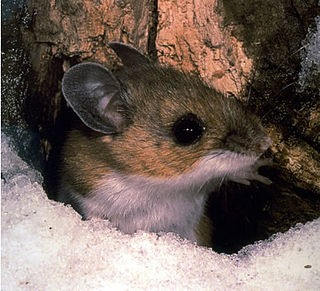
Peromyscus is a genus of rodents. They are commonly referred to as deer mice or deermice, not to be confused with the chevrotain or "mouse deer". They are New World mice only distantly related to the common house and laboratory mouse, Mus musculus. From this relative, Peromyscus species are distinguished by relatively larger eyes, and also often two-tone coloring, with darker colors over the dorsum (back), and white abdominal and limb hair-coloring. In reference to the coloring, the word Peromyscus comes from Greek words meaning "booted mouse". They are also accomplished jumpers and runners by comparison to house mice, and their common name of "deer mouse" is in reference to this agility.
Schmidly's deer mouse, is a recently described species of deer mouse from the mountains of western Mexico. It is part of the highly complex and well-studied Peromyscus boylii species complex. The uniqueness of Peromyscus from this area had long been suspected, but was only formalized in 2004 with the publication of its species description. The species was named in honor of David J. Schmidly, a mammalogist and former president of the University of New Mexico.

The Neotominae are a subfamily of the family Cricetidae. They consist of four tribes, 16 genera, and many species of New World rats and mice, predominantly found in North America. Among them are the well-known deer mice, white-footed mice, packrats, and grasshopper mice.

The Mexican volcano mouse is a species of rodent in the family Cricetidae endemic to high elevation areas of the Trans-Mexican Volcanic Belt.
Dickey's deer mouse is a species of rodent in the family Cricetidae. It is endemic to Mexico, being found only on a small island in the Gulf of California. The species is named for Donald Dickey, who sponsored the expedition that first discovered the animal.
Eva's desert mouse is a species of rodent in the genus Peromyscus of the family Cricetidae found only in the Baja California peninsula of Mexico.
Osgood's mouse is a species of rodent in the family Cricetidae. It is found only in Mexico. Its name references Wilfred Hudson Osgood.
The Guatemalan deer mouse is a species of rodent in the family Cricetidae. It is found in Guatemala and Mexico.
The naked-eared deer mouse is a species of rodent in the family Cricetidae. It is found in El Salvador, Guatemala, Honduras, Mexico, and Nicaragua.
Hooper's mouse is a species of rodent in the family Cricetidae. It is the only member of the Peromyscus hooperi species group, and is found only in Mexico. The species is named for Emmett Hooper, a researcher into the taxonomy of the genus Peromyscus.
The brown deer mouse is a species of rodent in the family Cricetidae found only in Mexico.
The plateau mouse is a species of rodent in the family Cricetidae. It is found only in Mexico.

The black-eared mouse, or black-eared deer mouse, is a species of rodent in the family Cricetidae, native to North America.

The Mexican deer mouse is a species of forest-dwelling rodent in the family Cricetidae. It is found in southern Mexico and throughout much of Central America.
The tawny deer mouse or marsh mouse is a species of rodent in the family Cricetidae. It is found only in Mexico.

The Nayarit mouse or Sinaloan deer mouse is a species of cricetid rodent endemic to Mexico. It was considered a subspecies of brush mouse until 1977.
The gleaning mouse is a species of rodent in the family Cricetidae. It is found only in Mexico.
Winkelmann's mouse is a species of rodent in the family Cricetidae found only in Mexico, and is named for John R. Winkelmann, who collected the first specimens.
The Yucatan deer mouse is a species of rodent in the family Cricetidae. The species is found in Mexico and Guatemala; an example habitat is the Petenes mangroves ecoregion of the Yucatan.
The transvolcanic deer mouse is a species of rodent in the genus Peromyscus of the family Cricetidae found only in Mexico.






